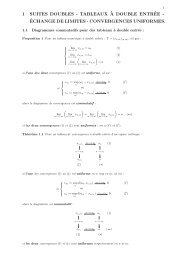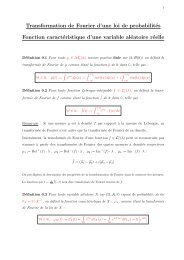Global warming
Global warming
Global warming
You also want an ePaper? Increase the reach of your titles
YUMPU automatically turns print PDFs into web optimized ePapers that Google loves.
<strong>Global</strong> <strong>warming</strong>IntroductionObservations and graphsCauses of the climate changeConsequences of the climate changeThe climate future of the Planet.: Matthieu BERCHER, Master M.I.G.S., University of Burgundy, 27/10/2008 08:45 :.Your NameYour TitleYour Organization (Line #1)Your Organization (Line #2)
(1) Introduction<strong>Global</strong> <strong>warming</strong> is the increase in the average temperature of the Earth'ssurface and oceans since the 20th century, and its projected continuation.During millions of years, the climate of the Earth had a lot of modifications.The various causes of these changes are volcanoes, sun.But for some decades, the influence of the manincreases and modifies the climate.On February 2007, the United Nations scientific paneldeclared that the evidence of a <strong>warming</strong> trend is"unequivocal," and that human activity has "verylikely" been the driving force in that change over thelast 50 years.Nowadays, <strong>Global</strong> <strong>warming</strong> is accepted byscientists as a fact.
(1) IntroductionTwo millennia of mean surface temperatures according to differentreconstructions.
(2) Observations and graphs<strong>Global</strong> surface temperature increased 0.74 ± 0.18 °C (1.33 ± 0.32 °F) duringthe 100 years ending in 2005.
(3) Causes of the climate changeThis <strong>warming</strong> is largely attributed to the increase of greenhouse gases(carbon dioxide and methane) in the Earth's atmosphere caused byhuman burning of fossil fuels, industrial, farming, and deforestationactivities.The Intergovernmental Panel on Climate Change (IPCC) concludes "most ofthe observed increase in globally averaged temperatures since the midtwentiethcentury is very likely due to the observed increase inanthropogenic greenhouse gas concentrations" via an enhancedgreenhouse effect.Natural phenomena such as solar variation combined with volcanoesprobably had a small <strong>warming</strong> effect from industrial times to 1950 and asmall cooling effect from 1950 onward.
(3) Causes of the climate change : Solar variation over the last thirty yearsSolar cycles led to a small increase of 0.07 percent in brightness. This effect istoo small to contribute significantly to global <strong>warming</strong>.
(3) Causes of the climate change : Carbon dioxide concentration over thelast 10,000 years.The carbon dioxide concentration increased a lot in the two last centuries.
(3) Causes of the climate change : Measures of Carbon Dioxideconcentration in Hawaii
Components of the current radiative forcing as estimated by the IPCCThe forces that drive climate change are said to be operating in a systemcalled forcing.
<strong>Global</strong> and continental temperature changeThis observations confirms that the increasing of temperature is due to thehuman activities.
Greenhouse gas emissions by country in 2000Poor regions, particularly Africa, appear in countries which their emissionshave been small compared to the developed world.
Per capita greenhouse gas emissions by country in 2000
(4) Consequences of the climate changeIncreasing global temperature is expected to cause sea levels to rise, anincrease in the intensity of extreme weather events, and significantchanges to the amount and pattern of precipitation, likely leading to anexpanse of tropical areas and increased pace of desertification. Otherexpected effects of global <strong>warming</strong> include changes in agricultural yields,modifications of trade routes, glacier retreat, mass species extinctions andincreases in the ranges of disease vectors.
Average glacier thickness change
Northern Hemisphere ice trends
Southern Hemisphere ice trends.
The ozone layerThe hole in the ozone layer is provoked by the gases rejected by humanactivity. This hole amplify the global <strong>warming</strong>.
(5) The climate future of the PlanetAverage global temperatures may increase by 1.4-5.8ºC (that's 2.5 - 10.4ºF) by the end of the 21st century.The difference between global temperatures during an Ice Age and an icefreeperiod is only about 5ºC.Warmer ocean water may result in more intense and frequent tropicalstorms and hurricanes. Sea levels are also expected to increase by 0.09 -0.88 m. In the next century, mainly from melting glaciers and expandingseawater . <strong>Global</strong> <strong>warming</strong> may also affect wildlife and species that cannotsurvive in warmer environments may become extinct. The global <strong>warming</strong>may result in the spreading of certain diseases such as malaria anddiseases due to the poor air quality.The future problems caused by rising seas, growing deserts, and morefrequent droughts which can affect the developing world more than richcountries.One study predicts 18% to 35% of a sample of 1,103 animal and plantspecies would be extinct by 2050, based on future climate projections.
(5) The climate future of the Planet : global <strong>warming</strong> predictionsThe globally averaged <strong>warming</strong> corresponds to 3.0 °C (5.4 °F).
Data Internethttp://en.wikipedia.org/wiki/Main_Pagehttp://www.nytimes.com...
The end
















